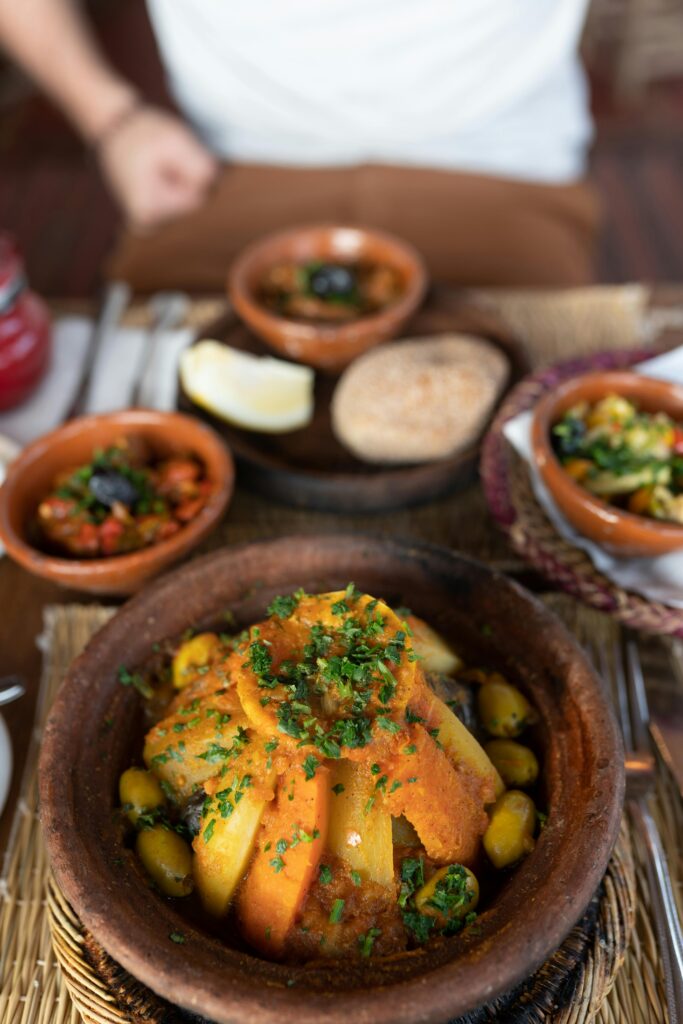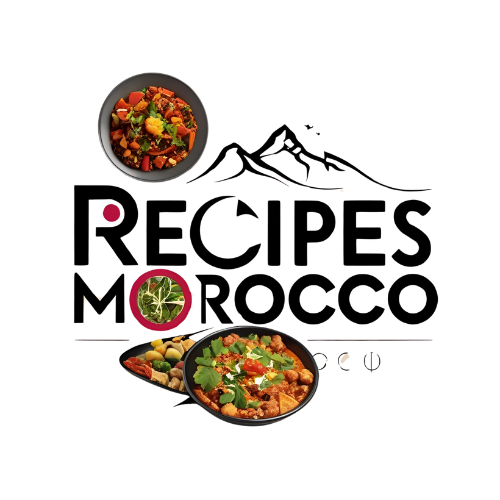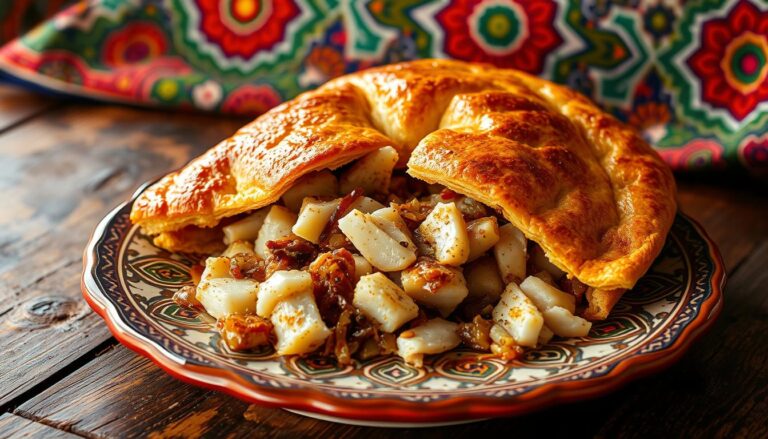Tagine Recipes: Mastering the Moroccan Stew

With its distinctive cooking technique and deep aromas, tagine, a typical Moroccan meal, perfectly captures the spirit of Moroccan cookery. Tagine, which gets its name from the clay pot it is prepared in, is a cultural activity that unites people and is more than just a meal. Steam can circulate through the tagine pot’s conical lid, keeping the food soft and imbued with flavorful spices. Originating in North Africa, this slow-cooking method has developed over ages under the influence of several cultures, including Mediterranean, Berber, and Arab customs. With a combination of spices, meats, vegetables, and fruits that showcase the area’s agricultural abundance, each tagine tells a tale. Ten delicious tagine recipes that each highlight a different aspect of this well-liked Moroccan meal will be covered in this post, along with advice on how to become an expert tagine cook.
Chicken Tagine with Olives and Preserved Lemons
The Chicken Tagine with Preserved Lemons and Olives is one of the most well-known tagine dishes; it strikes the ideal balance between acidic and savory ingredients. Bone-in chicken chunks are usually used in this recipe, marinated in a blend of spices like cumin, coriander, and ginger, as well as garlic and olive oil. The olives give the dish a saline depth, while the preserved lemons, a mainstay of Moroccan cooking, give it a clear citrusy punch. The flavors of the chicken blend harmoniously when it is cooked slowly in the tagine, producing meat that is tender and slips off the bone. This tagine, which is typically served with crispy bread or fluffy couscous, is a celebration of Moroccan hospitality and a must-try for anybody interested in learning more about the nation’s culinary traditions.
Lamb Tagine accompanied by almonds and apricots
A delectable dish that exemplifies the harmonic fusion of sweet and savory flavors that define Moroccan cooking is lamb tagine with apricots and almonds. Usually, shoulder or leg of lamb is used in this recipe. It is chopped into pieces, seared, and then mixed with a variety of spices, such as black pepper, turmeric, and cinnamon. The addition of almonds and dried apricots gives the soft lamb a contrasting texture and a wonderful flavor. Slowly cooking the tagine develops a rich and nuanced flavor profile by allowing the meat to absorb the natural sweetness of the fruit and the aromatic spices. This dish, which embodies the warmth of Moroccan hospitality, is ideal for festive occasions or family get-togethers and is frequently served with bread or couscous.
Seasonal Vegetables in a Vegetarian Tagine
A vegetarian tagine made with seasonal vegetables is a filling and healthy choice for anyone looking for a plant-based meal. This recipe calls for a range of vibrant veggies, including bell peppers, eggplant, zucchini, and carrots, which are sautéed with flavorful spices like cinnamon, paprika, and cumin. This dish is substantial and satisfying because chickpeas are frequently added for protein. The veggies are allowed to absorb the spices through the slow cooking process, creating a stew that is full of flavor and vibrancy. To provide a burst of freshness, fresh herbs like parsley or cilantro are usually sprinkled on top before serving. This vegetarian tagine demonstrates the versatility of Moroccan cuisine and is ideal for a hearty weekday meal or as the focal point of a party.
Chermoula on a fish tagine
A tasty dish that showcases Morocco’s seaside characteristics is fish tagine with chermoula. Before cooking, the fish is flavored with chermoula, a zesty marinade composed with garlic, herbs, spices, and lemon juice. Because it holds up well during cooking, firm white fish like cod or snapper are frequently used. Slices of bell peppers, tomatoes, and onions are piled on the tagine to give the fish a vibrant backdrop. A light and tasty supper is produced as the fish absorbs the natural sweetness of the veggies and the aromatic spices from the chermoula while it cooks. This fish tagine, which is usually served with crusty bread or couscous on the side, is a light and refreshing take on meat-based dishes that is ideal for warmer months or lighter meals.
Tagine of Beef with Walnuts and Prunes
A rich and filling recipe, Beef Tagine with Prunes and Walnuts blends the sweetness of prunes with the rich flavors of slow-cooked beef. Typically, this recipe calls for beef chuck or brisket that has been seasoned with a mixture of ginger, cinnamon, and cumin. The roasted walnuts offer a delicious crunch and an earthy flavor, while the prunes naturally sweeten the savory meat. The beef absorbs the spices and the sweetness of the prunes while becoming extremely soft thanks to the slow-cooking process. This tagine, served with steaming rice or fluffy couscous, is a great comfort food that warms the soul as well as the body, making it a great option for special events or family get-togethers.
Fig and Honey Quail Tagine
The delicate flavors of quail, which are frequently regarded as a delicacy in Moroccan cuisine, are highlighted in the opulent meal Quail Tagine with Figs and Honey. Before being seared to acquire a deep color, the quail is usually marinated in a blend of spices, such as saffron, ginger, and cinnamon. A delicious balance of salty and sweet is achieved by adding fresh figs, either dried or fresh, to the tagine along with a drizzle of honey. While adding the flavorful aromas of the spices and figs to the meal, the slow-cooking method guarantees that the quail stays soft. This sophisticated delicacy, which is a genuine monument to the craftsmanship of Moroccan cooking, is frequently saved for special events or festivals where its distinctive flavor combination can be enjoyed.
Rabbit Tagine accompanied by capers and olives
A novel take on the classic tagine, Rabbit Tagine with Olives and Capers offers a lower-protein alternative. Before being browned in the tagine, the rabbit meat is marinated in a mixture of spices, such as coriander, cumin, and garlic. The mild flavor of the rabbit is enhanced by the salty, acidic aspect that the addition of olives and capers brings. The flavors combine as the dish boils slowly, producing a flavorful stew that is filling and cozy. This tagine is frequently served with couscous or crusty bread so that guests may mop up the flavorful sauce. This rabbit tagine is perfect for daring diners and exemplifies the variety of ingredients found in Moroccan cooking.
Orange and Olive Duck Tagine
Duck Tagine with Orange and Olives is a sumptuous dish that blends the vibrant citrus flavors with the deep flavors of duck. Usually, the duck is seared to create a crispy skin after being seasoned with spices like ginger and cinnamon. Green olives and fresh oranges are added to the tagine, producing a delicious flavor contrast. The duck is made tender and tasty by the slow-cooking procedure, and the dish is given a refreshing zest by the orange juice. This tagine is a classy choice for dinner parties or festive events because it is frequently served with rice or couscous. This recipe is a great culinary joy since it perfectly captures the complexity of Moroccan cuisine with its blend of savory and sweet ingredients.
Chickpea and Sweet Potato Tagine
A satisfying and tasty vegetarian choice that brings out the inherent sweetness of sweet potatoes is Sweet Potato and Chickpea Tagine. Onions and garlic are first sautéed, and then spices like turmeric, coriander, and cumin are added. After that, cubed sweet potatoes and chickpeas are added to make a substantial and satisfying stew. A pleasant and cozy supper is produced by allowing the flavors to melt together through slow cooking. This tagine can be served with crusty bread or couscous and is frequently topped with fresh herbs like parsley or cilantro. This tagine demonstrates the diversity and richness of Moroccan cuisine and is perfect for a weekday supper or as a vegetarian alternative for parties.
Almonds and Raisins on a Pumpkin Tagine
A delicious recipe that honors the flavors of fall and winter is Pumpkin Tagine with Raisins and Almonds. Usually, the recipe calls for chopped pumpkin that has been sautéed with garlic and onions and then seasoned with nutmeg, ginger, and cinnamon. Almonds that have been toasted offer a delightful crunch, while raisins naturally sweeten the dish. A warm, fragrant stew is produced by slow-cooking the pumpkin, which softens and absorbs the spices. This tagine is a filling and cozy dish that is ideal for cold nights and is frequently served with warm bread or couscous. This dish’s blend of spicy and sweet flavors captures the spirit of Moroccan cooking, in which every component is essential to achieving a harmonic balance.
In conclusion
Discovering the rich flavors and customs of Moroccan cuisine is made possible by being proficient in the art of tagine cooking. The variety of ingredients and cooking methods that characterize this well-loved dish are highlighted in each tagine recipe, which tells a different tale. Tagine has plenty to offer everyone, from the bright flavors of vegetables and seafood to the savory undertones of lamb and poultry. You’ll learn the pleasures of slow cooking as you try out various recipes and ingredients. Slow cooking allows tastes to combine to create meals that are both comforting and fulfilling. Moroccan cuisine is recognized for its warmth and hospitality, and tagine is sure to impress and delight whether you’re hosting a dinner party or spending a relaxing evening at home. You can add a touch of Morocco to your kitchen and make delectable meals that honor the concept of sharing and community by adopting the customs and methods of tagine cooking.


